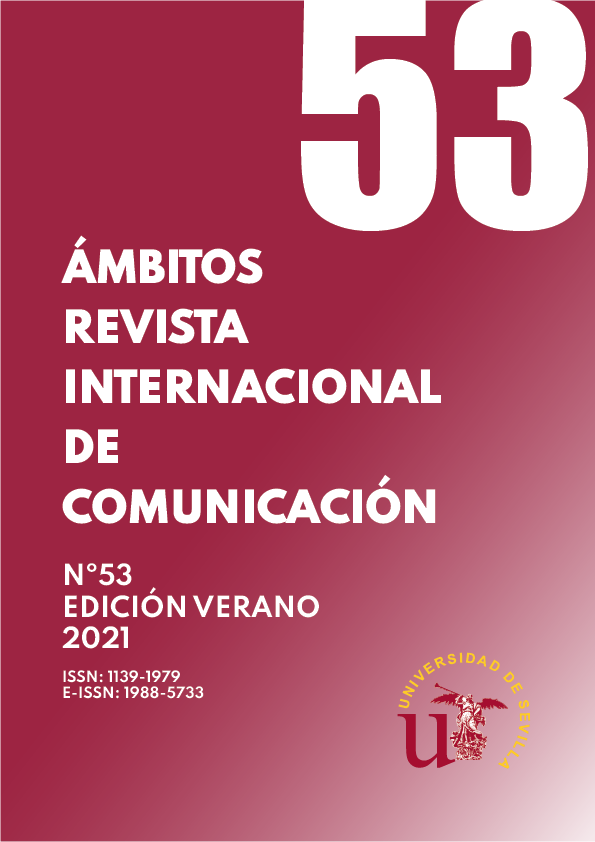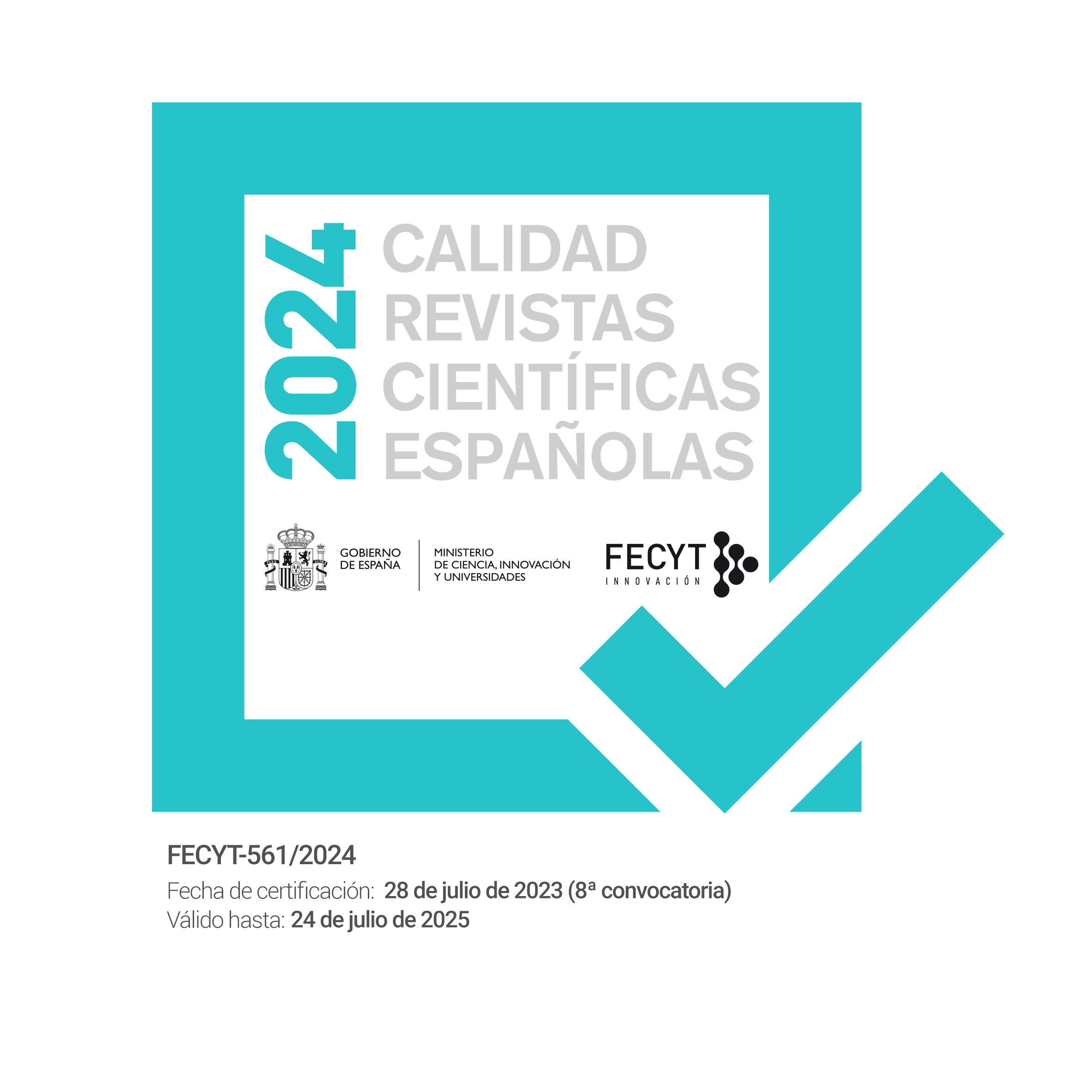Comunicación, salud y Covid-19. Cómo comunican los instagrammers sanitarios españoles
DOI:
https://doi.org/10.12795/Ambitos.2021.i53.03Palavras-chave:
Instagram, Comunicación y salud, Redes sociales, Influencer, COVID-19Resumo
La presente investigación tiene como objeto de estudio los recursos visuales empleados por sanitarios en sus publicaciones de Instagram durante las dos primeras semanas del confinamiento. El objetivo principal es conocer los recursos expresivos que emplean estos instagrammers , de qué modo emplean las herramientas que ofrece la plataforma para lograr una notable repercusión entre sus audiencias. La metodología empleada es mixta, cuantitativa y cualitativa. En el primer caso se usan programas como FanPageKarma e influencity.com para conocer las métricas digitales de los instagrammers (totalizan los números de seguidores, reacciones, engagement, calidad de la audiencia, sexo...). Y para el análisis de las publicaciones se ha confeccionado una ficha de análisis sobre el uso de recursos discursivos audiovisuales. Paralelamente se aplica el walkthrough method para conocer las potencialidades expresivas de Instagram. Como principales resultados podemos destacar el papel intermediador de los instagrammers que no actúan solamente como productores de mensajes sino también como transmisores de terceros realizando funciones de curación y gatekeeping. También concluimos que los usuarios que componen la muestra no aprovechan todas las potencialidades expresivas y de difusión de los mensajes que posee una herramienta como Instagram. De igual manera tampoco destacan por sus competencias comunicativas en cuanto al dominio del lenguaje y narrativas audiovisuales. A pesar de ello, el éxito de estos influencers expertos es patente, pudiendo hallarse sus causas en las excepcionales circunstancias provocadas por la pandemia del COVID-19 (en especial durante el periodo analizado) y la necesidad de la población de encontrar información veraz ante la incertidumbre.
Downloads
Referências
Aguado, J. M. (2020). Mediaciones ubicuas. Ecosistema móvil, gestión de identidad y nuevo espacio público. Gedisa.
Badia, A., Costales, Z. y del Valle, A. A. (2017). Comunicación audiovisual, nuevos paradigmas y tendencias. Alcance, 6(12), 26-55.
Barroso, J. (2002). Realización de los géneros televisivos. Síntesis.
Beck, U. (2002). La sociedad del riesgo global. Siglo XXI.
Bonet-Martí, J. (2020). Análisis de las estrategias discursivas empleadas en la construcción de discurso antifeminista en redes sociales. Psicoperspectivas, 19(3), 52-63. https://dx.doi.org/10.5027/psicoperspectivas-vol19-issue3-fulltext-2040
Bull, G. y Kajder, S. (2005). Digital Storytelling in the Language Arts Classroom. Learning & Leading with Technology, 32(4), pp. 46-49.
Carvalho, E.S.S., Vale, P.R.L.F., Pinto, K.A.. y Ferreira, S.L. (2021). Conteúdos relacionados a professionais de enfermagem durante a pandemia de COVID-19 na plataforma Youtube. Revista Braslieira de Enfermagem, 74, 1-11. doi: http://dx.doi.org/10.1590/0034-7167-2020-0581
Castro-Martínez, A. y Pérez Ordóñez, C. (2019). Formato horizontal o vertical, una decisión marcada por la edad y por la influencia de Instagram. El caso de la Generación Z en España. En Sierra Sánchez, J. y Lavin, J.M.: Redes sociales, tecnologías digitales y narrativas interactivas en la sociedad de la información (67-79). McGraw Hill. ISBN 8448618181.
Cortés, S., Méndez, L. y Lacasa, P. (2016). Ipads, Apps y Redes Sociales. Construyendo narrativas multimodales en las aulas. Digital Education Review, (30), pp. 53-75.
Costa, C. y López, X. (2020). Comunicación y crisis del coronavirus en España: primeras lecciones. El profesional de la información, v. 29, n. 3, e290304. https://doi.org/10.3145/epi.2020.may.04
Cunningham, S. y Craig, D (2019). Social Media Entertainment: The New Intersection of Hollywood and Silicon Valley. University Press.
De Aguilera-Moyano, M., Castro-Higueras, A., Pérez-Rufi, P. (2019). Entre Broadcast Yourself y Broadcast Whatever: La página de inicio de YouTube como síntesis de su identidad empresarial. El Profesional de la Información, 28 (2), (e280206), 1-14. https://doi.org/10.3145/epi.2019.mar.06
Fernández-Gómez, E. y Martín-Quevedo, J. (2018). La estrategia de engagement de Netflix España en Twitter. El profesional de la información, 27(6), 1292-1302.
Fuchs, C. (2020). Everiday Life and Everyday Communication in Coronavirus Capitalism. Triple C 18 (1): 375-399. http://www.triple-c.at
Garfin, D. D., Silver, R. C, y Holman, E. A. (2020). The Novel Coronavirus (COVID-2019) Outbreak: Amplification of Public Health Consequences by Media Exposure. Health Psychology. http://dx.doi.org/10.1037/hea0000875
Gerlitz, C. y Helmond, A. (2013). The like economy: Social buttons and the data-intensive web. New media & society, 15(8), 1348–1365.
Gibbs, M, Meese, J., Arnold, M. y Carter, M. (2015). Funerals and Instagram: Death, Social Media and Platform Vernacular. Information, Communication & Society. https://doi.org/10.1080/1369118X.2014.987152
Giddens, A. (1995). Modernidad e identidad del yo. (El yo y la sociedad en la época contemporánea). Península.
IAB Spain (2019). Libro Blanco del Marketing de Influencers. https://tinyurl.com/e9p87drd
IAB Spain (2020). Estudio redes sociales 2020. https://tinyurl.com/29spfkry
Igartua, J. J., Ortega, F. y Arcila, C. (2020). Unos de la comunicación en los tiempos del coronavirus. Un estudio transcultural. El profesional de la información, v. 29, n. 3, e290318. https://doi.org/10.3145/epi
Illera, J. L. R. y Monroy, G. L. (2009). Los relatos digitales y su interés educativo. Educação, Formação & Tecnologias-ISSN 1646-933X, 2(1), pp. 5-18.
Islas Carmona, O. (2010). Internet 2.0: el territorio digital de los prosumidores. Estudios Culturales, 3(5), 43-64.
Jenkins, H. (2007, 21 de marzo). Transmedia storytelling 101. Confessions of an Aca-Fan. https://tinyurl.com/4puz36uy
Juárez-Escribano, M. B. (2020). Análisis de la cultura virtual en las redes sociales como organización digital. Prisma Social: revista de investigación social, (30), 295-321.
Kim, J. W., Chadha, M. y Gil de Zúñiga, H. (2018). El uso de los medios de comunicación y la elaboración cognitiva: El paper mediador de la eficacia mediática. Revista Latina de Comunicación Social, 73, pp.168-183.
Lastra, A. (2016). El poder del prosumidor. Identificación de sus necesidades y repercusión en la producción audiovisual transmedia. Icono 14, (14), pp. 71-94. https://doi.org/10.7195/ri14.v14i1.902
Leaver, T., Highfield, T. y Abidin, C. (2020). Instagram: Visual Social Media Cultures (Digital Media and Society). Polity Press.
Light, B., Burgess, J. y Duguay, S. (2018). The walkthrough method: An approach to the study of apps. New media & society, 20(3), 881-900.
Pérez, M. (2020, 30 de enero). Tamaño recomendado para las fotos y vídeos de Instagram. Superadmin. https://tinyurl.com/y3ab7yrf
Peña, V. y Mañas, S. (2015). Narración digital, lectoautor, prosumidor y realidad. Opción, (2), pp. 866-876.
Percastre-Mendizábal, S., Pont-Sorribes, C. y Suau-Gomila, G. (2019). La gestión comunicativa en redes sociales digitales de la emergencia del Ébola en España. Revista Española de Comunicación en Salud, 80-90. https://doi.org/10.20318/recs.2019.4437
Pink, S. y Horst, H. (2019). Etnografía digital. Ediciones Morata.
Real Academia Española. (2019). Realizar. En Diccionario de la lengua española (actualización de la 23ª ed.). https://dle.rae.es/realizar
Salaverría, R., Buslón, N., López Pan, F., León, B., López Goñi, I. y Erviti, M. C. (2020). Desinformación en tiempos de pandemia: tipología de los bulos sobre la COVID-19. El profesional de la información, v. 29, n. 3, e290315. https://doi.org/10.3145/epi.2020.may.15
Sánchez, Paniagua y Bustos (2017) Análisis estratégico de la comunicación en red del Colegio oficial de Ingenieros de Telecomunicación (COIT). Colegio Oficial de Ingenieros de Telecomunicación.
Sandvine (2018). The Global Internet Phenomena Report. https://tinyurl.com/8cbu2473
Scolari, C. (2013). Narrativas transmedia: cuando todos los medios cuentan. Deusto.
Senft, T. M. (2012). Microcelebrity and the Branded Self. En Burgess, J. y Bruns, A. (eds): A Companion to New media Dynamics. Blackwell.
Toffler, A. (1980). La tercera ola. Plaza & Janés.
Wilson, C. (2014). User interface inspection methods. Elsevier.
Zuckerman, M. (2019, 24 de septiembre). Instagram: estadísticas globales y clave de 2019. Digimind. https://tinyurl.com/bnbh2n35
Downloads
Publicado
Como Citar
Edição
Seção
Licença
Copyright (c) 2021 Antonio Castro-Higueras, José Luis Torres-Martín, Mireya Carballeda-Camacho, Miguel de Aguilera-Moyano

Este trabalho está licenciado sob uma licença Creative Commons Attribution-NonCommercial-ShareAlike 4.0 International License.
Ámbitos. Revista Internacional de Comunicación é um jornal de acesso aberto, o que significa que todo o conteúdo está disponível gratuitamente para o usuário ou sua instituição. Os usuários podem ler, baixar, copiar, distribuir, distribuir, imprimir, pesquisar ou vincular ao texto completo dos artigos, ou utilizá-los para qualquer outra finalidade lícita, sem solicitar permissão prévia da editora ou do autor. Esta definição de acesso aberto está de acordo com a Iniciativa de Acesso Aberto de Budapeste (BOAI).

A menos que seja observado o contrário, todo o conteúdo da edição eletrônica é distribuído sob uma "Licença Internacional Creative Commons Attribution-NonCommercial-ShareAlike 4.0". Você pode consultar a versão informativa e o texto legal da licença aqui. Isto deve ser expressamente declarado desta forma, quando necessário.
No caso de aceitação do manuscrito, os autores cedem os direitos da obra para sua publicação à Ámbitos. Revista Internacional de Comunicación sob o contrato de licença Attribution-NonCommercial-ShareAlike 4.0 International (CC BY-NC-SA 4.0). Os autores retêm os direitos autorais e terceiros estão autorizados a copiar, distribuir e fazer uso da obra, desde que cumpram os termos e condições estabelecidos na licença
- Cite a autoria e a fonte original de publicação (revista, editora e URL da obra).
- Não utilizá-los para fins comerciais.
- Se você remixar, transformar ou criar a partir do material, você deve liberar suas contribuições sob a mesma licença que o original.
Mais informações podem ser encontradas em
https://creativecommons.org/licenses/by-nc-sa/4.0/deed.es


















